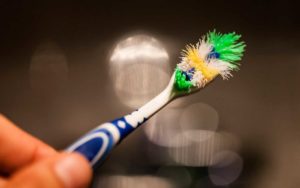Of course, daily brushing is essential for dental hygiene. But how hygienic is it to brush your teeth with an old toothbrush? The American Dental Association (ADA) recommends that you replace your toothbrush approximately every three to four months. Many dental professionals recommend changing your toothbrush about every three months.
If you are brushing twice daily (as recommended), then in 3 months, you will have brushed your teeth approximately 180 times! If you use your toothbrush for 4 months, that’s 240 brushes! Proper brushing should last about 2 minutes to thoroughly clean every crevice, tooth and tongue. Brushing should occur in soft circles and up and down (away from the gums) on your teeth.
For those who brush a little more vigorously than the soft circle motion recommended, their toothbrush head’s bristles tend to open up and flatten out in all directions. Children especially tend to be tough brushers. Some very young children bite down on their toothbrushes and suck the water and toothpaste off as they’re learning the habit of an oral routine. When these roughed up toothbrushes are being used, the bristles can’t properly move in between the teeth and just glide over the grooves.

No matter your brushing style, over time toothbrush bristles can become frayed and worn which may cause them to lose their effectiveness. Toothbrushes are used to remove plaque from building up on the teeth and well as clearing away any residual food. The nylon bristles must be intact to properly sweep through your mouth to bust through acids and bacteria that build up in your mouth throughout the day or night.
However, toothbrush bristles do not kill bacteria in the mouth, protect you against disease or prevent you from getting sick. If you are getting over being sick, it is extremely important to replace your toothbrush afterward. Failure to do so results in the continual spread of germs from the illness. It is also important to note that sharing toothbrushes are also dangerous to one’s oral health. This too can spread bacteria and disease among people.
The way toothbrushes are stored are also important to its care and longevity. After brushing, thoroughly rinse your toothbrush and place in a holder upright to air dry. Placing the head in a container can promote microbial growth. Toothbrushes are most commonly stored in the bathroom. “Toothbrushes have been shown to harbor bacteria (including fecal coliform bacteria that can be released into the air when the toilet is flushed or can be spread to the toothbrush when the owner touches a contaminated surface before handling his or her brush).”, according to the ADA. This is another reason to be sure to replace your toothbrush regularly.
Remember:
Replace your toothbrush every three to four months.
Buy either a new manual toothbrush or replace the head of your electric toothbrush.
Replacing your toothbrush after being sick is vital.
Never ever share your toothbrush with another person.
Store your toothbrush in a dry, open space in an upright position.







